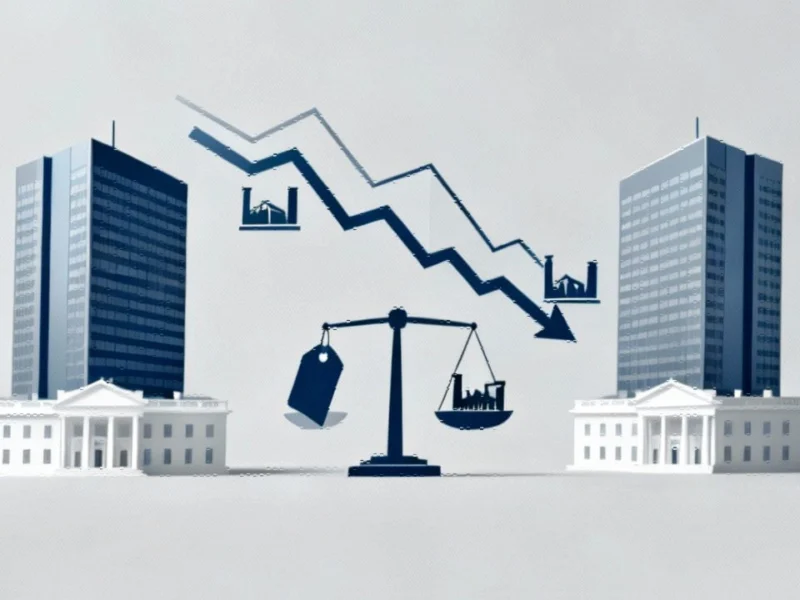Note: Featured image is for illustrative purposes only and does not represent any specific product, service, or entity mentioned in this article.
The New Pharmaceutical Negotiation Landscape
Recent agreements between the Trump Administration and pharmaceutical giants Pfizer and AstraZeneca represent more than just drug pricing deals—they signal a fundamental restructuring of how government leverage is transforming manufacturing strategy and technological investment across the healthcare sector. While much attention has focused on the consumer pricing aspects, the industrial computing and manufacturing implications are equally profound, particularly as companies commit billions to reshoring production and upgrading facilities.
Manufacturing Reshoring Takes Center Stage
The core of both agreements involves massive domestic investment commitments—$70 billion from Pfizer and $50 billion from AstraZeneca—that will reshape American pharmaceutical manufacturing. These investments come as companies seek protection from potential 100% tariffs, creating a new calculus for production strategy. The shift toward domestic manufacturing represents a significant departure from decades of globalization trends and will require substantial upgrades to industrial computing systems and automation technologies.
As companies like AstraZeneca build new $4.5 billion manufacturing facilities, they’re not just constructing plants—they’re implementing state-of-the-art industrial control systems that represent the latest in manufacturing technology. These facilities will likely incorporate advanced process automation, real-time monitoring systems, and sophisticated data analytics platforms to maintain competitive efficiency while meeting new pricing requirements.
The Data and Analytics Imperative
Beyond manufacturing, the agreements create new demands for evidence-based pricing justification. Pharmaceutical companies must now demonstrate outcomes that matter to patients at lower total costs, pushing them toward greater investment in analytics capabilities and real-world evidence generation. This represents a significant opportunity for industrial computing solutions that can handle complex data analysis across clinical, manufacturing, and economic domains.
The requirement to substantiate price differentials across global markets will drive adoption of advanced computing platforms capable of processing massive datasets. Companies that can effectively leverage these industrial computing technologies will have stronger negotiating positions, while those lacking robust data infrastructure may struggle to justify their pricing models.
Supply Chain and Operational Implications
The pharmaceutical industry’s response to these agreements extends beyond manufacturing facilities to encompass broader supply chain transformations. As companies reshore production, they must reconfigure complex global supply networks, requiring sophisticated inventory management systems and logistics platforms. This comes amid broader sector resilience challenges affecting multiple industries.
The move toward domestic manufacturing also creates opportunities for innovation in distribution and direct-to-consumer channels, including the forthcoming TrumpRx.gov platform. These developments parallel disruptive approaches seen in other sectors, where direct engagement with consumers is reshaping traditional business models.
Strategic Positioning in a New Regulatory Environment
Pharmaceutical companies now face a strategic imperative to develop comprehensive responses that balance multiple objectives: meeting pricing requirements while maintaining innovation capacity, investing in domestic manufacturing while managing global operations, and implementing new computing systems while controlling costs. The administration’s approach of setting framework requirements rather than prescribing specific solutions gives companies flexibility, but also demands sophisticated strategic planning.
This environment rewards companies that can effectively leverage advanced security and communication technologies to protect intellectual property and maintain operational integrity during this transition. As the broader implications of these agreements become clearer, companies across the healthcare sector are watching closely to understand how these new market dynamics will affect their own strategic planning.
Long-term Industry Transformation
The Pfizer and AstraZeneca agreements likely represent just the beginning of a broader industry realignment. Other pharmaceutical manufacturers will need to develop their own strategies for navigating this new environment, with many expected to announce similar deals in coming months. This transformation extends beyond pharmaceuticals to affect medical device manufacturers, biotechnology companies, and healthcare services providers.
As companies across the healthcare sector respond to these evolving market pressures, we’re likely to see increased investment in industrial computing systems that support more transparent, data-driven operations. The ability to demonstrate value through concrete evidence will become increasingly important, driving adoption of advanced analytics platforms and real-world evidence generation capabilities.
The coming years will test pharmaceutical companies’ ability to balance multiple competing priorities while maintaining their innovation edge. Those that successfully navigate this complex landscape will likely emerge stronger, with more efficient operations and clearer value propositions for patients, payers, and policymakers alike.
This article aggregates information from publicly available sources. All trademarks and copyrights belong to their respective owners.



